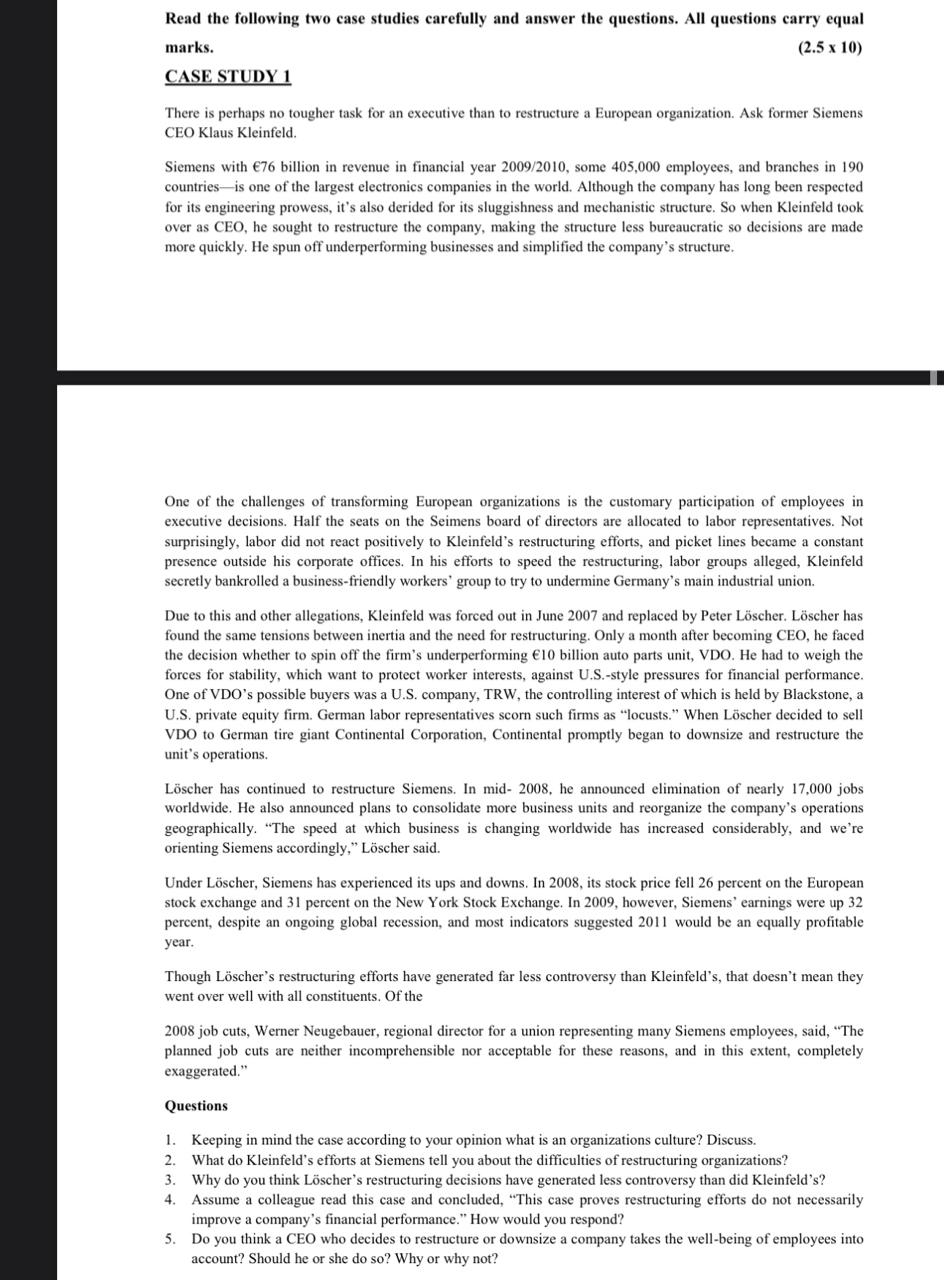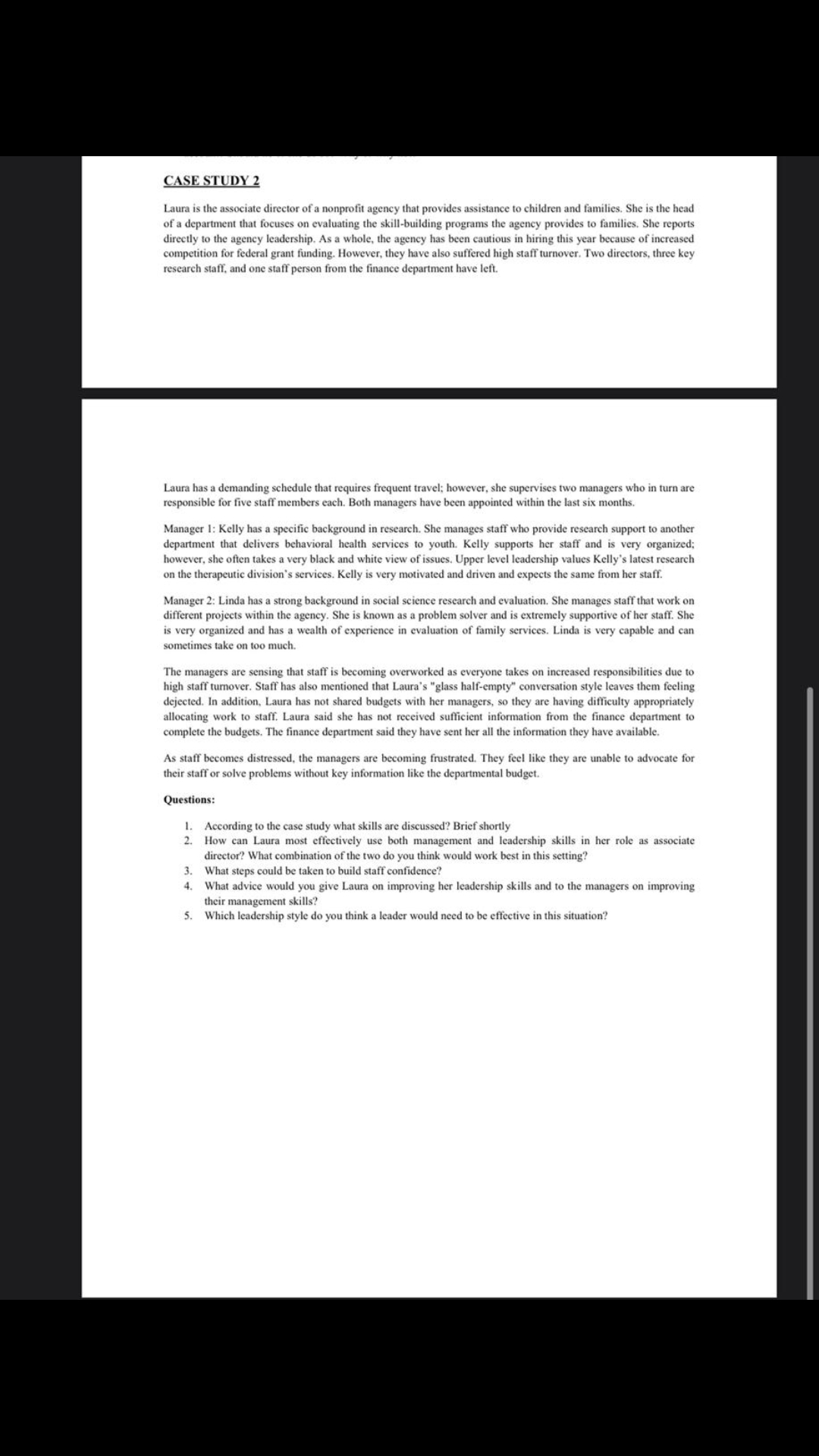- answerof the following question of case study
Read the following two case studies carefully and answer the questions. All questions carry equal marks. (2.5 x 10) CASE STUDY 1 There is perhaps no tougher task for an executive than to restructure a European organization. Ask former Siemens CEO Klaus Kleinfeld. Siemens with (76 billion in revenue in financial year 2009/2010, some 405,000 employees, and branches in 190 countries-is one of the largest electronics companies in the world. Although the company has long been respected for its engineering prowess, it's also derided for its sluggishness and mechanistic structure. So when Kleinfeld took over as CEO, he sought to restructure the company, making the structure less bureaucratic so decisions are made more quickly. He spun off underperforming businesses and simplified the company's structure. One of the challenges of transforming European organizations is the customary participation of employees in executive decisions. Half the seats on the Seimens board of directors are allocated to labor representatives. Not surprisingly, labor did not react positively to Kleinfeld's restructuring efforts, and picket lines became a constant presence outside his corporate offices. In his efforts to speed the restructuring, labor groups alleged, Kleinfeld secretly bankrolled a business-friendly workers' group to try to undermine Germany's main industrial union. Due to this and other allegations, Kleinfeld was forced out in June 2007 and replaced by Peter Loscher. Loscher has found the same tensions between inertia and the need for restructuring. Only a month after becoming CEO, he faced the decision whether to spin off the firm's underperforming C10 billion auto parts unit, VDO. He had to weigh the forces for stability, which want to protect worker interests, against U.S.-style pressures for financial performance. One of VDO's possible buyers was a U.S. company, TRW, the controlling interest of which is held by Blackstone, a U.S. private equity firm. German labor representatives scorn such firms as "locusts." When Loscher decided to sell VDO to German tire giant Continental Corporation, Continental promptly began to downsize and restructure the unit's operations. Loscher has continued to restructure Siemens. In mid- 2008, he announced elimination of nearly 17,000 jobs worldwide. He also announced plans to consolidate more business units and reorganize the company's operations geographically. "The speed at which business is changing worldwide has increased considerably, and we're orienting Siemens accordingly," Loscher said. Under Loscher, Siemens has experienced its ups and downs. In 2008, its stock price fell 26 percent on the European stock exchange and 31 percent on the New York Stock Exchange. In 2009, however, Siemens' earnings were up 32 percent, despite an ongoing global recession, and most indicators suggested 2011 would be an equally profitable year. Though Loscher's restructuring efforts have generated far less controversy than Kleinfeld's, that doesn't mean they went over well with all constituents. Of the 2008 job cuts, Werner Neugebauer, regional director for a union representing many Siemens employees, said, "The planned job cuts are neither incomprehensible nor acceptable for these reasons, and in this extent, completely exaggerated." Questions 1. Keeping in mind the case according to your opinion what is an organizations culture? Discuss. 2. What do Kleinfeld's efforts at Siemens tell you about the difficulties of restructuring organizations? 4. Why do you think Loscher's restructuring decisions have generated less controversy than did Kleinfeld's? Assume a colleague read this case and concluded, "This case proves restructuring efforts do not necessarily improve a company's financial performance." How would you respond? 5. Do you think a CEO who decides to restructure or downsize a company takes the well-being of employees into account? Should he or she do so? Why or why not?CASE STUDY 2 Laura is the associate director of a nonprofit agency that provides assistance to children and families. She is the head of a department that focuses on evaluating the skill-building programs the agency provides to families. She reports directly to the agency leadership. As a whole, the agency has been cautious in hiring this year because of increased competition for federal grant funding. However, they have also suffered high staff turnover. Two directors, three key research staff, and one staff person from the finance department have left. Laura has a demanding schedule that requires frequent travel; however, she supervises two managers who in turn are responsible for five staff members each. Both managers have been appointed within the last six months. Manager 1: Kelly has a specific background in research. She manages staff who provide research support to another department that delivers behavioral health services to youth. Kelly supports her staff and is very organized; however, she often takes a very black and white view of issues. Upper level leadership values Kelly's latest research on the therapeutic division's services. Kelly is very motivated and driven and expects the same from her staff. Manager 2: Linda has a strong background in social science research and evaluation. She manages staff that work on different projects within the agency. She is known as a problem solver and is extremely supportive of her staff. She is very organized and has a wealth of experience in evaluation of family services. Linda is very capable and can sometimes take on too much. The managers are sensing that staff is becoming overworked as everyone takes on increased responsibilities due to high staff turnover. Staff has also mentioned that Laura's "glass half-empty" conversation style leaves them feeling dejected. In addition, Laura has not shared budgets with her managers, so they are having difficulty appropriately allocating work to staff. Laura said she has not received sufficient information from the finance department to complete the budgets. The finance department said they have sent her all the information they have available. As staff becomes distressed, the managers are becoming frustrated. They feel like they are unable to advocate for their staff or solve problems without key information like the departmental budget. Questions: 1. According to the case study what skills are discussed? Brief shortly 2. How can Laura most effectively use both management and leadership skills in her role as associate director? What combination of the two do you think would work best in this setting? 3. What steps could be taken to build staff confidence? 4. What advice would you give Laura on improving her leadership skills and to the managers on improving their management skills? Which leadership style do you think a leader would need to be effective in this situation








